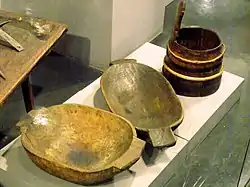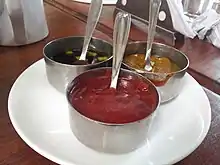Kaymak
Kaymak, sarshir, or qashta/ashta (Persian: سَرشیر Saršir; Arabic: قشطة Qeshta or قيمر Geymar; Kurdish: Qeymax), is a creamy dairy food similar to clotted cream, made from the milk of water buffalo, cows, sheep, or goats in Central Asia, some Balkan countries, some Caucasus countries, the countries of the Levant, Turkic regions, Iran and Iraq. In Poland, the name kajmak refers to a confection similar to dulce de leche instead.[1]
 Kaymak from Turkey | |
| Alternative names | Malai |
|---|---|
| Course | Breakfast and dessert |
| Place of origin | Central Asia |
| Region or state | Iraq, Syria, Iran, India, Mongolia, Georgia, Greece, Lebanon, North Macedonia, Serbia, Romania, Turkey, Egypt, Montenegro, Bosnia and Herzegovina, Afghanistan, Azerbaijan, Uzbekistan, Kazakhstan, Pakistan, India, Kurdistan |
| Main ingredients | Milk |
| Variations | Kaymer, Qaymer, Qeimer, Qaymiq, Qashta, Ashta, Makahan |
The traditional method of making kaymak is to boil the raw milk slowly, then simmer it for two hours over a very low heat. After the heat source is shut off, the cream is skimmed and left to chill (and mildly ferment) for several hours or days. Kaymak has a high percentage of milk fat, typically about 60%. It has a thick, creamy consistency (not entirely compact, because of milk protein fibers) and a rich taste.[2]
Etymology
The word kaymak has Central Asian Turkic origins, possibly formed from the verb kaymak, which means 'melt' and 'molding of metal' in Turkic.[3] The first written records of the word kaymak is in the well-known book of Mahmud al-Kashgari, Dīwān Lughāt al-Turk. The word remains as kaylgmak in Mongolian, which refers to a fried clotted cream, and with small variations in Turkic languages as qaymaq in Azerbaijani, qaymoq in Uzbek, қаймақ in Kazakh and Shor, каймак in Kyrgyz, kaymak in Turkish,[3] gaýmak in Turkmen, კაიმაღი (kaimaghi) in Georgian, καϊμάκι (kaïmáki) in Greek, and кајмак (kajmak) in Serbo-Croatian, caimac in Romanian. This dairy food is called sarshir in Iran. This word means 'top of the milk'. They use this name because after boiling milk, a layer of fat stands on the top of the boiled milk. [4][5]
Turkey

Shops in Turkey have been devoted to kaymak production and consumption for centuries. Kaymak is mainly consumed today for breakfast along with the traditional Turkish breakfast. One type of kaymak is found in the Afyonkarahisar region where the water buffalo are fed from the residue of poppy seeds pressed for oil. Kaymak is traditionally eaten with baklava and other Turkish desserts, fruit preserve and honey or as a filling in pancakes.
Balkans
.jpg.webp)

Known as kajmak, it is almost always made at home, though commercial production is on the rise. Kajmak is most expensive when freshest—only a day or two old. It can keep for weeks in the refrigerator but becomes harder and loses quality.[6] Kajmak can also be matured in dried animal skin sacks; one variation is called skorup. Kajmak also describes the creamy foam in the Turkish coffee, and a lot of other coffees in the Balkans.
It is usually enjoyed as an appetizer or for Saturday morning breakfast, as Saturdays are market days with the best kajmak, but also as a condiment. The simplest recipe is lepinja s kajmakom (pita bread filled with kajmak), consumed for breakfast or as fast food. Bulgarians, Bosnians, Montenegrins and Serbs consider it a national meal. Other traditional dishes with kajmak (sold in restaurants) include pljeskavica s kajmakom (the Balkan version of a hamburger patty topped with melted kajmak), as well as ribić u kajmaku (beef shank, simmered with kajmak).
Iraq
In Iraq, it is called geymar or qeimar (قيمر) and is very popular. Iraqi geymar is usually made from the rich fatty milk of cows or buffaloes, which are prevalent in the marshes of southern Iraq.
It is available both factory-produced and from local vendors or farmers as geymar Arab.
Iraqis like to serve geymar for breakfast with fresh bread, honey or jam. However, the most popular way is to spread it on a type of Iraqi pastry bread called kahi, smother it with date honey and then wash it down with hot tea. Qeymar on kahi with date syrup or honey is a long-standing traditional breakfast in Baghdad and throughout southern and northern Iraq.
Iran
In Iran, sarsheer (سرشیر) is used to describe a different method which does not involve heating the milk, thus keeping enzymes and other cultures of the milk alive. The word kaymak (qaymaq) is also used for the boiled method. Qaymaq is a Turkish word used to describe this product among the Azari people of Iran.
Afghanistan
In Afghanistan, qaimak or qaymaq has a thinner quality and is eaten for breakfast meals usually with bread. People typically top qaimak with honey, sugar, or mix it with jam. It can be spread on pastries or even added to milk tea. Qaimak can be purchased at grocery stores in Afghanistan or made at home. It is quite a long process to make at home, involving hours stirring the milk pot. Qaimak can be found at Afghan/Iranian grocery stores in the west, but is not as rich as homemade. While a lot qaimak variations are made from buffalo milk, Afghan qaimak can be made from cows' milk.
Georgia

In the Adjara region of Georgia, bordering Turkey, კაიმაღი (kaimaghi) is made from cow's milk in homes in the mountainous municipalities of Keda, Shuakhevi, and Khulo. It is typically eaten with Georgian cheese and/or bread, and is only rarely served in restaurants.
Greece
Kaïmaki (καϊμάκι) is a soft cream cheese that can be spread on bread or used in cooking as a filling in food and for deserts. Kaïmaki can also be found as a chewy ice cream that is flavoured with mastic.
See also
Citations
- "Polish Chocolate and Dulce de Leche Mazurek". Polish Your Kitchen. 9 April 2017. Archived from the original on 29 June 2021. Retrieved 27 February 2021.
- "Kaymak Recipe". 24 January 2021. Retrieved 12 August 2021.
- "kaymak" (in Turkish). NişanyanSözlük. Retrieved 13 July 2017.
- (in Romanian) https://laptariacucaimac.ro/. Retrieved 2022-02-02.
{{cite web}}: Missing or empty|title=(help) - "kaymak in Romanian - English-Romanian Dictionary | Glosbe". glosbe.com. Retrieved 2022-02-02.
- Vrzić, Nikola (December 28, 2000). "Sve srpske kašike" (Windows-1250). NIN (in Serbian). Retrieved 13 June 2012.
References
- The Poppy Growers of İsmailköy (2002)
- Davidson, Alan. Oxford Companion to Food (1999). "Kaymak", pp. 428–429. ISBN 0-19-211579-0
- An Introduction into the Serbian Cuisine
External links
![]() Media related to Kaymak at Wikimedia Commons
Media related to Kaymak at Wikimedia Commons
